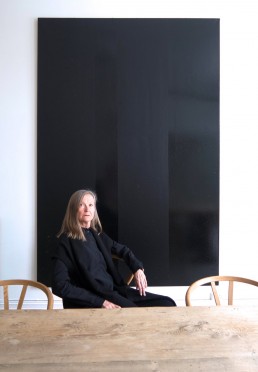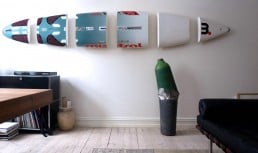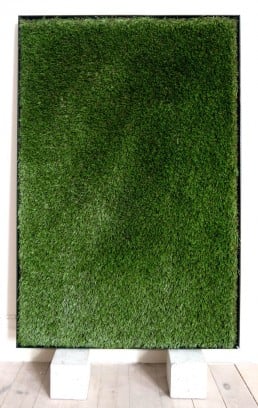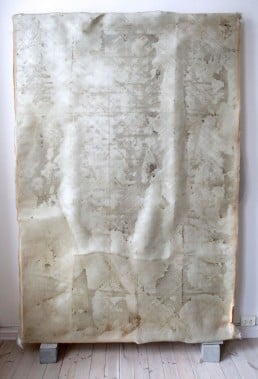Interview: Art Collector Irene Sævik
Growing up in the northwest coast of Norway, surrounded by fjords and high mountains, it wasn’t on the cards that art was to become a crucial part of Irene Sævik’s life. A visit at Hennie Onstad Kunstsenter in 1968 turned out to change this. A selection of works by Josef Albers opened up a new universe to Irene Sævik, who since then has been wandering more than mountain tops – the compelling, beautiful and thought-provoking paths of the art world, that is. Driven by a strong curiosity, she keeps taking new turns that constantly feed her need to live with art on a daily basis.

Name: Irene Sævik
Location: Oslo
Started collecting in year: 2004
Number of artworks in collection: 50
Name of collection: IRENE SÆVIK / in memory of PETER AMDAM
What is your earliest memory of art, and what led you to start collecting it?
Growing up in the northwest coast of Norway, surrounded by fjords and high mountains, museums and galleries were not on the agenda. Living in close proximity to nature, the biggest issue was whether we could make it to the top of the mountain when hiking. During my first visit to Oslo in 1968, I visited the newly opened Hennie Onstad Kunstsenter where works by Josef Albers were exhibited. For me, who always liked drawing and doing mathematics, these works opened up a new universe. Later on, I combined my work as an architect with painting myself and ended up collecting art as well. Even though I bought a few pieces of art in the beginning of the Eighties, I would say that I really started collecting after I bought a work by Jakob Schmidt in 2004.

How would you describe yourself as an art collector?
There exists a sort of ambivalence between my wish to make art myself, my passion for art, and my need to live with art, and this makes me a somehow intuitive driven collector who buys art more spontaneously, when a piece of art touches me. However, I do not operate with any strategy. Since my oldest son, Peter Amdam, worked with artists, both as art critic and curator, I bought art from different exhibitions that he curated. Part of my collection is also bought in collaboration with him and some works are even from exhibitions dedicated to Peter after he passed away too young.
What is the main motivation behind your collecting?
Just my passion for art. The love of art, smell of oil, the feeling of being in a studio, being with good friends. These elements almost become part of my self, my identity, and my family.
Describe your collection in three words.
International, contemporary, young artists.
Is there any particular type of art that appeals to you or anything that unites all the works in your collection?
I feel very attracted to monochrome paintings, be it non-figurative, non-visual, non-narrative works, that are reduced to a minimal expression, but I also highly appreciate works centering around colour, architecture, zen, introversion, reticence, conceptualism, and recycling.
How important is it for you to meet the artist behind the artwork?
It is not very important, but very stimulating for sure – especially if I meet the artist after I have bought some of her/his work.
What is the most recent piece of art you added to your collection and why?
A work by Matias Faldbakken has been on my wish list for a long time, but I was always too late to get hold of my favourites. Then about a year ago on a visit to gallery Standard, one of his Carbon Dioxide bottles was on display. That one is now in my collection. I recently also acquired pieces by Mari Slattelid, Yves Scherer and Goutam Ghosh.

Has digitalization changed the way you collect art?
No, not yet. However, following galleries on the internet makes it easy to follow what is going on and to look up new artists.
What or who has influenced you as a collector?
My own interest in drawing and painting, my education and work as an architect where I very often also find inspiration in art pieces when developing concepts. In particularly the movements Constructivism, Modernism and Minimalism have been important to me. Also traveling, looking up architecture, visiting galleries, art fairs, museums, and so on. My own looking for meaning, my passion and my curiosity, and of course my son Peter, who brought me closer to young artists, has influenced me a lot.
Is there any specific place you always return to when you need an art fix?
No specific places. My decisions are normally based on my intuition and personal preferences.
The art market has a reputation of being a playground for the elite. What is your experience of this?
I think that there will always be collectors with advisors and money, and critics with a complex language. You have to find your own way, and trust your own nose.
Where do you think the future of the art market is headed?
Impossible to know. It will grow for sure, both because the world becomes more global and the growing digitization, but also because of financial investment. Each generation has its own character, things go very fast. For the moment, it looks like everything is allowed, things are moving and changing very fast.


Top three pieces of advice for new collector
1. See as much as you can
2. Trust your own intuition
3. Buy when you have the possibility
Top three art destinations
1. Basel
2. London
3. New York
Get your free copy of Artland Magazine
More than 60 pages interviews with insightful collectors.
